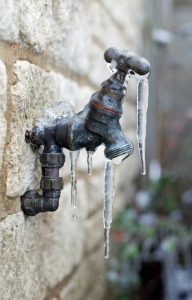More people file insurance claims for water damage than they do for fire damage, which is why frozen pipes are something to avoid. Unfortunately, you have to start preparing for frozen pipes well before the weather turns bitterly cold, but with the right guidance, you can ensure your pipes survive the winter intact.
Start before the temperature drops below freezing
Before things get too cold, it’s best to get proactive. One of the first things you can do is to detach any garden hoses you have hooked up outside. Removing the hoses, emptying them of water, and then draining the water from the spigot can prevent damage to the hose and spigot pipes. If you need to use the hose during months where the temperature is freezing, just remember to disconnect the hose when you’re done, and drain both the hose and the spigot.

It’s wise to take the time and perform regular inspections on the inside and outside of your home as the weather turns cold. Getting a visual on any exposed plumbing pipes can clue you in as to whether they’re protected from becoming frozen.
Find the vulnerable water lines
Even water lines that cross through crawl spaces in the house can become frozen, so if you’re able to, taking a peek inside is usually adequate. If you can see daylight coming into the crawl space, then you’ll know those lines are vulnerable to freezing if the temperature drops enough.
Pipes inside your exterior walls aren’t always safe from freezing temperatures but there are two simple ways to ensure the pipes stay warm during the winter.
Your first option is to install insulation between the cold side of the wall and the pipes themselves. This will protect them from extreme low temps and prevent freezing. Your other option is to install small air vents in the wall to transfer some of your house’s heat to the pipes so that they don’t freeze.
If neither of the above options are practical because of the placement of pipes, such as beneath a sink, you can always keep the cabinet doors ajar when the temperature drops to freezing to give heated air the chance to warm your pipes.
Adjusting the thermostat smartly
Setting your thermostat to a constant 65 degrees Fahrenheit is an easy way to keep your home and pipes warm enough to prevent frozen plumbing. If your thermostat allows for it, you can also disable the nighttime setback if it gets too cold outside. Just be sure to enable it when the weather gets warmer.
Anytime you leave home for an extended period of time during the winter, it’s never a bad idea to keep the thermostat at no lower than 55 degrees Fahrenheit, and open any cabinet doors that might hide plumbing.
To truly protect your pipes from winter freezing, contact the professionals
Maybe your house is older than most or you simply live in an area prone to very low temps; but if you expect frozen pipes to be a common issue, contact a trusted HVAC company to inspect your plumbing system. They can give you the best guidance on how to reduce your risk of frozen pipes.
